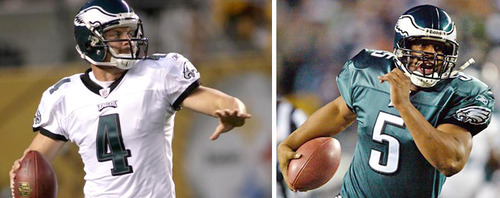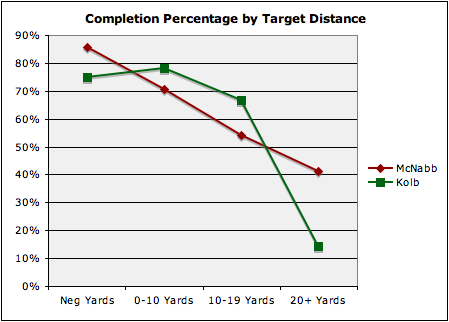
Plenty of speculation recently about about the future of the Eagles offense. Can LeSean McCoy, minus six pounds, take over for Brian Westbrook? Will the offensive line pull its weight? Is there a new #1 receiver? Should the Eagles switch to Kelly Green permanently? Well, maybe not that last one.
Perhaps most centrally, people want to know how the Eagles passing game will be different from previous years. Receivers have come and gone, but for the most part Donovan McNabb defined the offense. How will it change with Kevin Kolb stepping up? Marty Mornhinweg has already talked vaguely about a shift:
“[The offense] will be different. Donovan was such a great player, and he has many, many strengths, however they’re different from Kevin’s… I thought Donovan, there’s no question, he had one of the stronger arms, maybe of all time. He could make the brilliant play. Kolb is very, very consistent. He handles two or three different play selections very well. Typically, very accurate. He is athletic, but he doesn’t have the athleticism that Donovan has. So, very different in that way.”
The obvious change, based on our own eyes, is the difference in arm strength and accuracy. Donovan was tremendous at throwing the deep ball, but infamous for being rather streaky in the short/mid-range passes. Kolb doesn’t have that cannon arm, but he’s supposedly “more accurate.” Will that influence the play calling? And how much? Can we find a way to see what the passing offense will look like come September?
I think so, using Pro Football Focus’s play-by-play game stats from last year to compare the playcalling and accuracy with Kolb in the game versus McNabb. Just a trove of information over at PFF, but I’m going to utilize a only small segment: passes organized by where they were thrown. Also added in some other stats like the percentage of attempts thrown, completion percentage, and a basic yards per attempt calculation. Here you go: 
First things first: Kolb’s numbers are victim to small sample size problems. Kolb threw only 20% of the balls that McNabb did, so his stats aren’t as reliable (although they do refute the stupid myth that Andy might run the ball more with Kolb). They are likely to change as he plays more. Perhaps Kolb’ll get better starting every day. Or maybe teams will get used to him and learn how to rattle him. Impossible to tell. Either way, the numbers can tell us a lot about the differences from last year (when Kolb and McNabb were playing with the same supporting casts), and what we might be able to expect in 2010.
Let’s first look at playcalling, represented by the number of pass attempts:

Clearly Kolb threw a lot more short passes — an over 15% bump. Also, the percentage of times he chucked it long was cut almost in half from McNabb’s numbers. The gaps may not look huge on the graph but consider them over the course of a season. If he throws at the same pace as McNabb, Kolb will get in 80 more short (0-10 yards) passes and about 36 fewer long balls (20+ yards). That’s a major difference in play-calling (or could partially be execution) and would indicate a somewhat more “typical” west-coast offense is in town.
Okay, so Kolb is throwing more short passes. But is he completing more of them?

The short answer is yes. In everything from 0-19 yards, McNabb had a 65.9% completion percentage. Kolb completed 75.3% of those same passes. That is undoubtably a more accurate quarterback, and could help the Eagles offense become, in Marty’s words, “very, very consistent.”
However, there is an absolutely enormous gap in completion percentage on longer passes. Donovan completed a ridiculous 41% of his throws over 20 yards. Kolb, with limited action, only completed one in seven attempts (granted, that one did go for a 71-yard TD). If that trend continues, it would be a ridiculous swing what would make the Eagles much less inclined to go to the long ball.
Still, completion percentage alone doesn’t get us exactly what we want. It only shows how accurate the two quarterbacks are over the distances, but not how productive they are at each level. Which is where YPA comes in…

In my mind, this is the most striking graph. Essentially YPA measures the expected output from any given pass attempt. We can see what the “best” plays are to call because the estimated yards gained shows us the optimal point. For example, look at McNabb’s numbers — the farther he threw the ball, the better the outcome was, on average, for the offense. This is the simple reason why the Eagles threw the ball so much downfield in recent years. You can complain about boom-bust, but when McNabb was behind center, the Eagles gained maximum output when he was passing it 20 yards or more down the field.
For Kolb, at least right now, that is not the case. His sweet spot is in the intermediate, 10-19 yard range. That’s where Kolb’s accuracy makes him most productive (actually just as productive as McNabb throwing long).
So what does this all mean? It means yes, there will be many fewer bombs launched 45 yards down the field to DeSean Jackson. But it doesn’t mean, in any way, that the Eagles will be less explosive — or that Jackson won’t be as productive (as has been the current meme, debunked by Derek at IgglesBlog). It simply means the throws that result in explosive plays will be different. Rather than launching passes to Jackson after he’s 5 yards past the centerfielder, Kolb will have to get him the ball in the short and intermediate areas. From there it will up to Jackson (and Maclin, Celek, Avant) to run past or through defenders.
For an example, look no further than the two games Kolb started last year, from which we’ve gotten the rest of this data. Check out DeSean’s stats from those games versus the rest of the year:
DeSean may not have gone out as far before he caught the ball, but he was just as — if not more — productive and explosive with Kolb behind center. DeSean got more targets, receptions, yards, and touchdowns than he had in the average game with McNabb, plus had his two longest receptions of the year — all because of Yards After the Catch. Jackson already ranked 9th in the NFL last year with 6.6 YAC per Reception (25% of snaps or more). Yet Jackson’s 15 YAC/Rec. over two games with Kolb throwing him the ball blows away the rest of the receivers.
The explosion will still be in the passing game next season. Based on these numbers though, it’ll just be in a slightly different package.
Update: Kolb confirms the new focus of the offense—
“It’s going to be spectacular. With [DeSean’s] talent and hopefully my ability to get him the ball in stride and yards after the catch, those types of things — it will be pretty special. I look forward to being around him and both of us being with this team for a long time.”